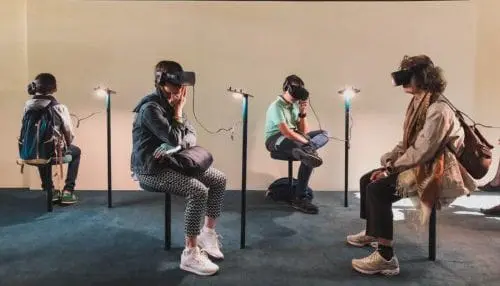Voice technology. Can charities harness the power of words?
Voice technology is something we're all still getting to grips with. Sure, it makes flicking to the next track simple but is it eavesdropping on our lives? Does it make us lazy? In the charity sector there is a similar level of uncertainty. How can it help charities? How are organisations already using it? We decided to explore the concept of Voice in the third sector.
Since the inception of the Internet, the world has witnessed the rapid evolution of the digital space and the technologies that have come with it. The overwhelming influence of digital is evidenced in changing consumer behaviours, with more and more of the UK population demonstrating digital-savviness, turning to online platforms for access to information, to buy goods, and to socialise. The digital space has become an inherent part of everyday life and has become interwoven into the very fabric of society with the Millennial and Generation Z demographics being the two most technologically savvy groups to date.

Subsequently, and admittedly unsurprisingly, we have seen a dramatic rise in digital adoption on behalf of businesses looking to reap the benefits of marketing digitally, and the rewards that can be claimed in terms of penetration and expansion in the hopes of reaching overarching business objectives. However, generally speaking, charities have been less inclined to pursue digital opportunities, with contemporary research evidencing a clear disparity between digital adoption amongst smaller charities and major actors in the field. Research suggests this is primarily down to a lack of digital skills (31%), a lack of time to develop a digital presence (24%) and lastly, due to the perception that it is not worth the investment (9%).
Here at Reason Digital, we believe that digital provides new opportunities to do good. We believe that there is scope to use digital platforms and services to reach a new audience and support people that previously may not have been reached. We would always encourage social enterprises, charities and NGOs to endorse digital platforms, to target the new digitally-savvy customer, and make them aware that we also exist in the digital world we’ve all become so accustomed to. Plus, whilst data can be quite intimidating, it provides so much useful information that can be used to grow, develop and learn. We don’t want digital to be something that charities are afraid of, it should be accessible to all. We want to help charities harness the power of digital to support their mission as technology provides new, innovative ways to have an impact. We have witnessed it provide profound tangible outcomes that benefit some of society’s most vulnerable; with our app ‘Safety Nets’ being a great example.
However, many charities are still struggling to engage with digital platforms; and given that digital is moving and developing at such an incredible rate, it is a concern that not all charities are not going to be able to keep up with new opportunities. In light of this, it is interesting to consider whether charities across the spectrum, whether small or large, have begun to think about one of the more contemporary subjects in the field of digital marketing: voice.
VA (Voice Assistance): Yes or No?
Whilst still in its infancy, UK household ownership of smart-voiced controlled speakers (voice assistance speakers) has reached 13%. One of the greater barriers to its adoption would appear to be that 48% see it as an awkward way to engage with technology.

Undoubtedly the organisations behind these products are iterating their functionality, so it will be interesting to see how it develops to encourage or adapt online purchasing behaviours – if at all. One of the more prolific industries that strive to benefit from voice is the supermarket sector – or for our American friends – the grocery sector. They seek to address the growing curiosities of the 69% of smart voice-controlled speaker owners who report using voice to add to their shopping list. Contrastingly, only 32% of owners see single-item purchasing using a digital-assistance as favourable. This begins to raise questions about the functionality of VAs amongst different industries and sectors. Indeed, given that the marketing advantages of VAs are only currently being explored by specific sectors such as the supermarket industry, there is the very real question of how relevant all these technological advancements are for the charity sector.
Is it likely that charities are going to see benefits by adopting this new opportunity, or are they limited by a lack of skills, confidence or resources to ever invest seriously in this developing trend?
Something for everyone?
Voice is one of the more accessible ways to communicate, so surely this provides a new way for individuals with accessibility needs to articulate their requirements with a digital support service. We like the idea of a charity receiving an automated message at the request of an individual simply by using their voice. They could request bookings, immediate support, or even more medication. Not only does it save the customer time, but it also helps with prioritising needs and resources to the relevant people. It can be synced with CRM systems, email addresses or automated text services. It is just an abstract example, but we think it demonstrates how technology can be used to make an experience more efficient and simple for a service user.
The Early Adopters
Already we are seeing some of the larger, more prolific charities seeking out ways to utilise voice assistant technology. Cancer Research UK have produced the ‘Alcohol Tracker’ which encourages you to log in your alcohol consumption, to incentivise people to limit their intake. Similarly, the British Red Cross have created ‘First Aid by Red Cross’ which allows you to ask Alexa for advice in a variety of first aid situations ranging from helping someone with a nosebleed to someone with a broken bone. Clearly, there are opportunities to begin to experiment with voice and test its applicability within the sector. A point we want to highlight is that these new, shiny, expensive technologies are there to be used, but not for the sake of using them. Consider your problem, goal or objective as a charity or non-profit and then consider what are the steps to reach that goal? Is voice something that can aid in the journey? If so, start experimenting. If not, don’t feel the need to adopt a new, trendy form of tech unnecessarily and without justified reason.
Voice your thoughts!
Do you think it is too early to start considering smart-voice products, or can you see the benefit of this service for the charity sector? In some ways, we think there are more pressing opportunities for the sector and that charities need to engage more confidently with alternatives platforms for digital marketing for the time being. On the other hand, we think that it is a great topic, that is genuinely an interesting consideration, that should be discussed amongst charity groups. Ultimately the more we talk about the significance of digital, and the real impact it can have on the third sector and more importantly, its service users, the more comfortable we become – and that can never be a bad thing.
Let us know what you think, we’d love for you to share your ideas about how we can begin to use voice to give charities a digital advantage. Let us find out together if our digital voice can do good for those who need support, and if you want to chat, or have an idea which we can get involved in, give us a call.
More tech trends this way...
-

Can AWS Wavelength help charities with AR and VR?
Virtual Reality (VR) and Augmented Reality (AR) might be exciting for gamers, but charities should also be feeling the buzz.
Find out more
-

7 ways charities can embrace technology to improve their services
It’s no secret that the charity sector has been one of the hardest hit by COVID-19. Between the shops closing, volunteers unable to help, and a drop in fundraising opportunities, almost every aspect of a charity’s day-to-day has been impacted. And even though stores are allowed to open again soon, the whole sector will still be feeling the effects.
Find out more
-

Twitch for charities: Supercharge your digital donations strategy and level up using Twitch
With charities being set to lose more than £4bn in just three months as a result of COVID-19, the fundraising landscape has changed drastically for the third sector. And it feels like it happened overnight. With digital fundraising hastily climbing its way to the top of the priority list as events are cancelled all over the world, there are platforms out there which charities may have never interacted with before, that are now becoming an essential part of fundraising strategies. One of these platforms is Twitch.
Find out more



